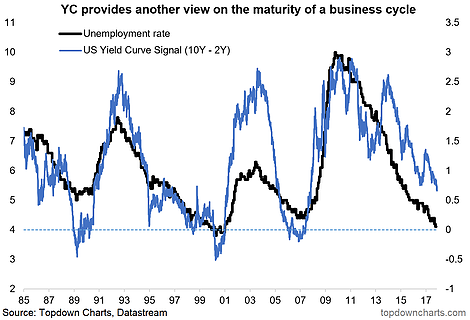The topic of the yield curve is one that has been coming up a lot lately, particularly as the 10s minus 2s spread has dipped to the lowest point since just prior to the financial crisis. A few people have referenced this as a bearish signal, and it's true that you tend to see a contraction in the spread between the 10-year and 2-year Treasury yield towards the end of a business cycle, with the yield curve often inverting in the lead-in to a recession. If you track the yield curve against the unemployment rate you can see clearly how the two indicators both provide insight into the maturity of the business cycle.
To this end you could certainly say we're late cycle at this point. But I also wanted to point out the patterns in bond market volatility. Looking at the second chart which tracks implied volatility in the bond market (think of it as the bonds VIX), bond volatility tends to pick up later in the cycle, and at present we're actually seeing record lows in bond market volatility. So taken together the yield curve and unemployment rate are pointing to a maturing business cycle, and bond volatility says the cycle is not over yet...
The US Government Bond yield curve (10-year minus 2-year) provides an insight into the maturity of the business cycle, and thus unsurprisingly tracks in line with the unemployment rate.

Bond volatility typically rises towards the later stages of the business cycle. At this point the various measures of bond market implied volatility are around record lows.

